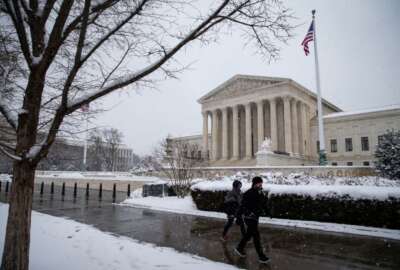
High court lets military implement transgender restrictions
The Supreme Court is allowing the Trump administration to go ahead with its plan to restrict military service by transgender men and women while court challenges...
WASHINGTON (AP) — The Trump administration can go ahead with its plan to restrict military service by transgender men and women while court challenges continue, the Supreme Court said Tuesday.
The high court split 5-4 in allowing the plan to take effect, with the court’s five conservatives greenlighting it and its four liberal members saying they would not have. The order from the court was brief and procedural, with no elaboration from the justices.
The court’s decision clears the way for the Pentagon to bar enlistment by people who have undergone a gender transition. It will also allow the administration to require that military personnel serve as members of their biological gender unless they began a gender transition under less restrictive Obama administration rules.
The Trump administration has sought for more than a year to change the Obama-era rules and had urged the justices to take up cases about its transgender troop policy immediately, but the court declined for now.
Those cases will continue to move through lower courts and could eventually reach the Supreme Court again. The fact that five justices were willing to allow the policy to take effect for now, however, makes it more likely the Trump administration’s policy will ultimately be upheld.
Both the Justice and Defense departments released statements saying they were pleased by the Supreme Court’s action. The Pentagon said its policy on transgender troops is based on professional military judgment and necessary to “ensure the most lethal and combat effective fighting force.” Justice Department spokeswoman Kerri Kupec said lower court rulings had forced the military to “maintain a prior policy that poses a risk to military effectiveness and lethality.”
Before beginning to implement its policy the administration is expected to need to make a procedural filing in one case in Maryland challenging the plan. That request could be made this week.
Groups that sued over the Trump administration’s policy said they ultimately hoped to win their lawsuits over the policy. Jennifer Levi, an attorney for GLBTQ Legal Advocates & Defenders, said in a statement that the “Trump administration’s cruel obsession with ridding our military of dedicated and capable service members because they happen to be transgender defies reason and cannot survive legal review.”
Until a few years ago service members could be discharged from the military for being transgender. That changed under the Obama administration. The military announced in 2016 that transgender people already serving in the military would be allowed to serve openly. And the military set July 1, 2017, as the date when transgender individuals would be allowed to enlist.
But after President Donald Trump took office, the administration delayed the enlistment date, saying the issue needed further study. And in late July 2017 the president tweeted that the government would not allow “Transgender individuals to serve in any capacity in the U.S. Military.” He later directed the military to return to its policy before the Obama administration changes.
Groups representing transgender individuals sued, and the Trump administration lost early rounds in those cases, with courts issuing nationwide injunctions barring the administration from altering course. The Supreme Court put those injunctions on hold Tuesday, allowing the Trump administration’s policy to take effect.
The Trump administration’s revised policy on transgender troops dates to March 2018. The policy generally bars transgender people from serving unless they do so “in their biological sex” and do not seek to undergo a gender transition. But it has an exception for transgender troops who relied on the Obama-era rules to begin the process of changing their gender.
Those individuals, who have been diagnosed with “gender dysphoria,” a discomfort with their birth gender, can continue to serve after transitioning. The military has said that over 900 men and women had received that diagnosis. A 2016 survey estimated that about 1 percent of active duty service members, about 9,000 men and women, identify as transgender.
___
Associated Press reporter Lolita C. Baldor contributed to this report.
Copyright © 2025 The Associated Press. All rights reserved. This website is not intended for users located within the European Economic Area.




